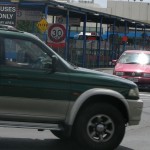Give Way Rule Change, Tougher Drink Driving Moves On Way
Tougher measures against drink driving and a change to the present right hand give way rule for turning traffic are part of the transport minister’s Safer Journeys 10-year road safety plan announced today.
Later in the year there will be a change to the give way rule. A “package of measures” related to this will be introduced and after Cabinet approval, there will be public consultation.
The NZTA will then conduct a media campaign to support the changes.
Next month, Steven Joyce will take to Cabinet a plan to get tougher on drink driving including:
- a zero drink-drive limit for drivers under 20
- Either lowering the legal blood alcohol concentration (BAC) from BAC 0.08 to 0.05, or conducting New Zealand specific research on the level of risk posed by drivers with a BAC between 0.05 and 0.08.
- compulsory devices to lock up a vehicle when drink is detected
- consideration of tougher penalties for traffic offences and motorists causing death or serious injury
 Mr Joyce says the Cabinet has not yet reached a final decision about whether or not to reduce the current adult drink drive limit from 0.08 to 0.05.
Mr Joyce says the Cabinet has not yet reached a final decision about whether or not to reduce the current adult drink drive limit from 0.08 to 0.05.
“This is a very finely balanced argument and we need to ensure that New Zealanders understand the difference between 0.05 and 0.08 and what impact a change would have on the road toll.
“Most New Zealanders, when asked, agree that the drink drive limit should be at a level of alcohol consumption that equates to a 0.05 limit. However, when you ask them whether the current 0.08 limit should be lowered to 0.05, they are split on the issue.
“I’ve said all along that road safety measures only work if they have the broad support of road users – and we’d want to be sure New Zealanders understand the benefits of a change and support it before proceeding,” says Mr Joyce.
Alcohol Healthwatch Director Rebecca Williams says implementing zero tolerance for under-20s is likely to be counter productive if the adult limit is not also reduced.
“Putting the onus on young people alone to solve this problem is completely unacceptable when adults are not expected to set a positive example.”
As indicated earlier, the driving age goes from 15 to 16.
Novice drivers will have to have 120 hours of supervised practice before being able to drive alone and there will be an investigation into vehicle power restrictions for young people, presumably to curb boy racers.
The minister says all of the measures being considered by Cabinet have been successful in other countries. “We’ve been particularly keen to learn from Australia, which has a much stronger road safety record, both generally and particularly among young people.
“Across the Tasman, for example, young Australians have a road fatality rate of 13 per 100,000 of population, while young New Zealanders have a fatality rate of 21 per 100,000 of population.”
Later in the year there will be moves to improve motorcycle rider training and licensing, including licensing of mopeds and a power to weight restriction for novice riders.
The minister said he chose as targets for his plan
- Young drivers
- Alcohol and drug impaired drivers
- Motorcycling
- Roads and roadsides
- Safer speeds
Mr Joyce says these areas were chosen as priorities because they are problem areas where real gains can be made. “We need this change if we are to benefit from a road system with fewer deaths and injuries.”
Labour’s Damien O’Connor said Labour will support legislation to increase the driving age through to select committee which will enable Labour to hear evidence from those who believe it will help reduce the road toll as well as those who may be affected such as those who live rurally.
“The real issue with young drivers in New Zealand is a lack of experience and having access to cars which are too powerful for their limited driving ability.”
JOYCE’S PLAN: Read it here











3 Comments
“This is a very finely balanced argument and we need to ensure that New Zealanders understand the difference between 0.05 and 0.08 and what impact a change would have on the road toll.”
In other words, he will not do it, even though it has been shown in numerous countries to have massive beneficial effects.
0.05, 0.08 This ain’t gonna make much difference to the most dangerous threat on the roads, the recidivist drunk driver. Tougher sentences for third time offenders and lifetime bans should be part of the Law reforms. Death by drunk drivers should be considered a violent crime and the penalties reflective of this. I believe that killing someone through drunk driving is manslaughter.
Gerald, I agree (on the manslaughter). The issue is that by concentrating on recidivist drunk drivers, you make it appear that the “normal Kiwi bloke” who “just that one time” drives home drunk is okay.
He’s not. The recidivist probably can actually handle himself better drunk, because he’s likely to be a habitual drunk. That doesn’t excuse him of course - but we need to crack down on both, and make drunk driving socially much more unacceptable.
And lower drunk driving limits have been shown to (eventually) create that social result.